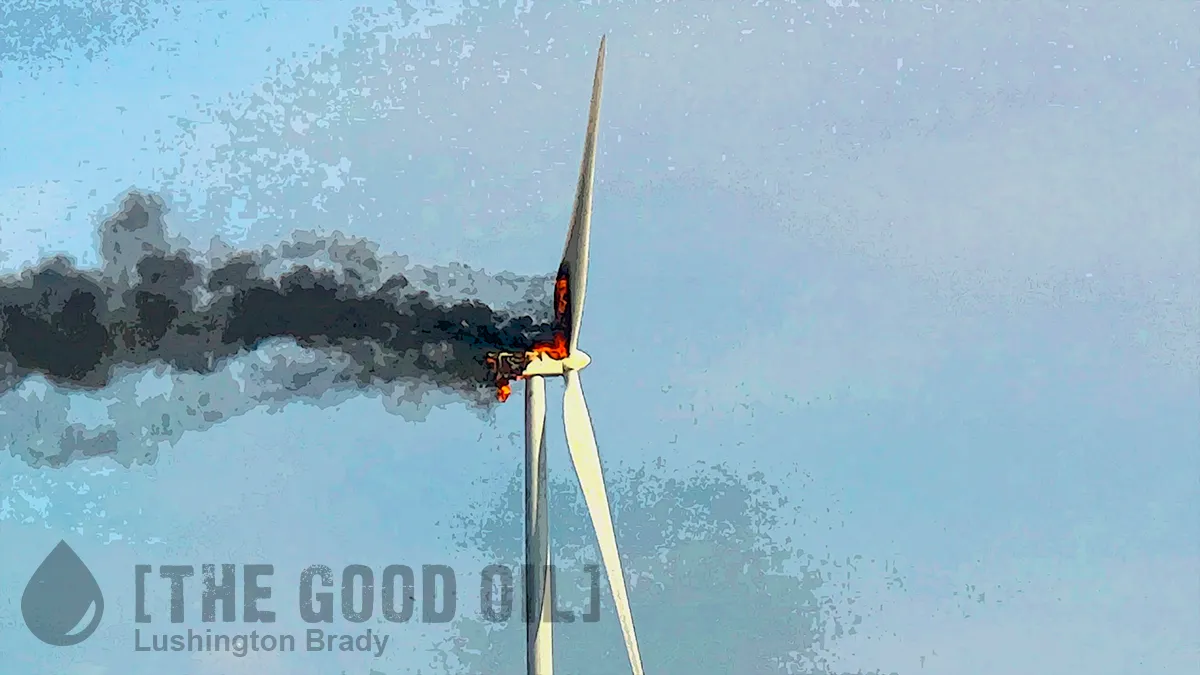Table of Contents
We’re all well aware by now of the hazards that wind turbines pose to birds and bats. We’re aware of that because, unlike Climate Cultists, we don’t turn a blind eye. But here’s a hazard I bet you weren’t aware of: farmers getting poleaxed by flying debris from wind turbines.
This startling new development comes to us, big surprise, courtesy of Australia’s wokest state.
Victorian farmers are being told to wear hard hats on their properties as shards of sharp plastic fly off brand new wind turbines. Locals in Victoria’s rural west have reported finding pieces of wind turbines, including serrated trailing edges, in the vicinity of the $3 billion green-energy project. Owners of the federal and state government-backed Golden Plains Wind Farm — 65km northwest of Geelong — contacted neighbouring landowners earlier this month to warn them about “blade serration detachment” following wild winds.
By ‘in the vicinity of’, they mean, nearly a kilometre away.
Western Victoria Liberal MP Bev McArthur, who raised the issue in parliament last week, said her constituents were finding pieces as far as 750 metres from the turbines.
“One of my constituents, Russell Coad, found these serrated trailing edges 750 metres from the turbine on his farm, and other pieces fell within metres of the Barunah CFA fire shed,” she said.
“The extreme weather event which caused this problem for the turbines was – you have guessed it – wind.”
That’s right, wind turbines are a particular hazard… in the wind.
The $3 billion project is set to become Australia’s largest wind farm and will power more than 765,000 homes.
But will it?
Let’s look at some of those back-of-the-envelope calculations the Climate Cult are so allergic to.
In a typical game of pea-and-shells, spruikers of ‘renewables’ love to talk in terms of ‘installed capacity’. But installed capacity is not the same as actual output: installed capacity is the theoretical maximum output of a system working at full capacity. Which wind and solar almost never do.
Take a deployment of wind turbines and of solar panels, each of which deployment has a registered capacity of 1.5 GW, bringing the total to 3 GW. Bear in mind that on average wind and solar deliver only about 30 per cent or so of their registered capacity. Let’s say on one particular full day they intermittently deliver 24 GWh (or 33 per cent of their registered capacity). And suppose they provide power to a town of 40,000 households; which, for the purpose of the exercise, requires electricity in a steady stream over the full day totalling the same 24 GWh.
Theoretically, the ‘renewables’ should just keep up. Theoretically.
How will they perform? It is not possible to say in the abstract. It depends on the wind and sun. I’ll keep it simple to avoid confusing complexity. Let’s say in the day in question we get eight hours of good wind, four in daylight, overlapping eight hours of reasonable sun, and four at night […]
During the four overlapping hours as much as 1.5 GW (wind) plus 1.5 GW of sun (=3 GW) is delivered continuously. Plenty to spare for charging a big battery. During the four hours of sun, when the wind is still, as much as 1.5 GW is delivered continuously. Still enough spare for charging. During the night the wind delivers four hours of 1.5 GW continuously; and, again, there is scope for charging. However for 12 hours nothing is being delivered when 12 GWh is required.
Ah, but ‘big batteries’! But big batteries, like solar panels and wind turbines, cost money. A lot of money.
How much surplus power has been generated? The answer in my simplified example is 12 GWh. So, there is potentially enough spare power. Then, how much would it cost to build a 12 GWh battery to store the power?
I will use the middling estimate of the US National Renewable Energy Laboratory for the capital cost of a battery in 2030. US$326 per kWh is its estimate. So one GWh would cost US$326 million. And 12 GWh would cost US$3.91 billion. This comes to US$97,800 per household in the aforementioned town.
Nearly four billion dollars, just to keep the lights on in a small-ish town. Maybe.
Doubling the size of the installed capacity wouldn’t help, because the 12 GWh battery imposes a hard limit on how much power can be supplied when the sun isn’t shining and the wind isn’t blowing.
Oh, but how often does that happen?
Electrical engineer Paul Miskelly analysed data produced by AEMO for the first half of 2010. He found that there were 58 intervals of various durations in which the output from the whole fleet of wind farms across Eastern Australia fell below two per cent of registered capacity, the longest for 19 hours.
But the wind is always blowing somewhere, surely?
Only sometimes. And then, it absolutely requires overbuilding in every region, which is costly; it requires a myriad of interconnecting power lines, which is costly; and it falsely presupposes that wind droughts are seldom if ever widespread.
Better stock up on candles and gas bottles, folks.
Providing they’re not banned by then.









